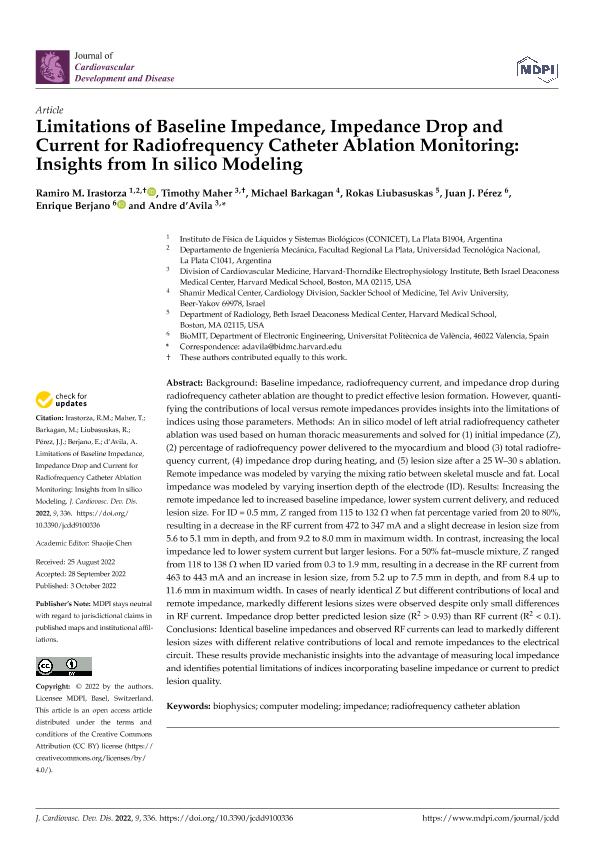Artículo
Limitations of Baseline Impedance, Impedance Drop and Current for Radiofrequency Catheter Ablation Monitoring: Insights from In silico Modeling
Irastorza, Ramiro Miguel ; Maher, Timothy; Barkagan, Michael; Liubasuskas, Rokas; Pérez, Juan J.; Berjano, Enrique; D’Avila, Andre
; Maher, Timothy; Barkagan, Michael; Liubasuskas, Rokas; Pérez, Juan J.; Berjano, Enrique; D’Avila, Andre
 ; Maher, Timothy; Barkagan, Michael; Liubasuskas, Rokas; Pérez, Juan J.; Berjano, Enrique; D’Avila, Andre
; Maher, Timothy; Barkagan, Michael; Liubasuskas, Rokas; Pérez, Juan J.; Berjano, Enrique; D’Avila, Andre
Fecha de publicación:
10/2022
Editorial:
MDPI
Revista:
Journal of Cardiovascular Development and Disease
ISSN:
2308-3425
Idioma:
Inglés
Tipo de recurso:
Artículo publicado
Clasificación temática:
Resumen
Background: Baseline impedance, radiofrequency current, and impedance drop during radiofrequency catheter ablation are thought to predict effective lesion formation. However, quantifying the contributions of local versus remote impedances provides insights into the limitations of indices using those parameters. Methods: An in silico model of left atrial radiofrequency catheter ablation was used based on human thoracic measurements and solved for (1) initial impedance (Z), (2) percentage of radiofrequency power delivered to the myocardium and blood (3) total radiofrequency current, (4) impedance drop during heating, and (5) lesion size after a 25 W–30 s ablation. Remote impedance was modeled by varying the mixing ratio between skeletal muscle and fat. Local impedance was modeled by varying insertion depth of the electrode (ID). Results: Increasing the remote impedance led to increased baseline impedance, lower system current delivery, and reduced lesion size. For ID = 0.5 mm, Z ranged from 115 to 132 Ω when fat percentage varied from 20 to 80%, resulting in a decrease in the RF current from 472 to 347 mA and a slight decrease in lesion size from 5.6 to 5.1 mm in depth, and from 9.2 to 8.0 mm in maximum width. In contrast, increasing the local impedance led to lower system current but larger lesions. For a 50% fat–muscle mixture, Z ranged from 118 to 138 Ω when ID varied from 0.3 to 1.9 mm, resulting in a decrease in the RF current from 463 to 443 mA and an increase in lesion size, from 5.2 up to 7.5 mm in depth, and from 8.4 up to 11.6 mm in maximum width. In cases of nearly identical Z but different contributions of local and remote impedance, markedly different lesions sizes were observed despite only small differences in RF current. Impedance drop better predicted lesion size (R2 > 0.93) than RF current (R2 < 0.1). Conclusions: Identical baseline impedances and observed RF currents can lead to markedly different lesion sizes with different relative contributions of local and remote impedances to the electrical circuit. These results provide mechanistic insights into the advantage of measuring local impedance and identifies potential limitations of indices incorporating baseline impedance or current to predict lesion quality.
Palabras clave:
BIOPHYSICS
,
COMPUTER MODELING
,
IMPEDANCE
,
RADIOFREQUENCY CATHETER ABLATION
Archivos asociados
Licencia
Identificadores
Colecciones
Articulos(IFLYSIB)
Articulos de INST.FISICA DE LIQUIDOS Y SIST.BIOLOGICOS (I)
Articulos de INST.FISICA DE LIQUIDOS Y SIST.BIOLOGICOS (I)
Citación
Irastorza, Ramiro Miguel; Maher, Timothy; Barkagan, Michael; Liubasuskas, Rokas; Pérez, Juan J.; et al.; Limitations of Baseline Impedance, Impedance Drop and Current for Radiofrequency Catheter Ablation Monitoring: Insights from In silico Modeling; MDPI; Journal of Cardiovascular Development and Disease; 9; 10; 10-2022; 1-12
Compartir
Altmétricas



